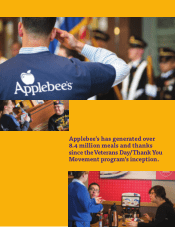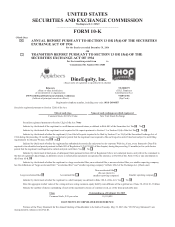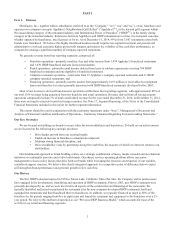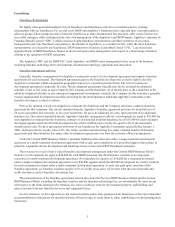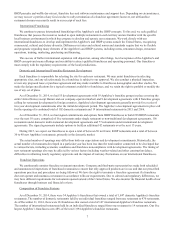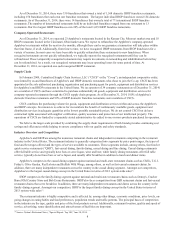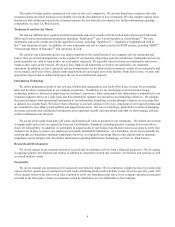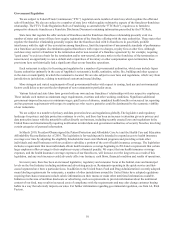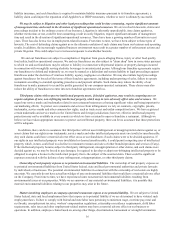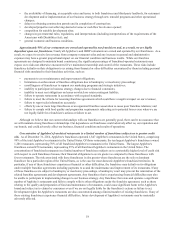IHOP 2014 Annual Report Download - page 27
Download and view the complete annual report
Please find page 27 of the 2014 IHOP annual report below. You can navigate through the pages in the report by either clicking on the pages listed below, or by using the keyword search tool below to find specific information within the annual report.8
As of December 31, 2014, there were 330 franchisees that owned a total of 1,568 domestic IHOP franchise restaurants,
including 150 franchisees that each own one franchise restaurant. The largest individual IHOP franchisee owned 154 domestic
restaurants. As of December 31, 2014, there were 14 franchisees that owned a total of 71 international IHOP franchise
restaurants. The number of international restaurants held by an individual franchisee ranged from one restaurant to 13
restaurants. Our five largest IHOP franchisees own 24% of the total 1,639 IHOP franchise restaurants.
Company-Operated Restaurants
As of December 31, 2014, we operated 23 Applebee's restaurants located in the Kansas City, Missouri market area and 10
IHOP restaurants located in the Cincinnati, Ohio market area. We expect to refranchise the Applebee's company-operated
Applebee's restaurants within the next twelve months, although there can be no guarantee a transaction will take place within
that time frame, if at all. Additionally, from time to time, we have reacquired IHOP restaurants from IHOP franchisees for a
variety of reasons. In most cases we have been able to quickly refranchise these restaurants to new franchisees. When
reacquired restaurants are not quickly refranchised, we typically operate the reacquired restaurants until they can be
refranchised. These temporarily reacquired restaurants may require investments in remodeling and rehabilitation before they
can be refranchised. As a result, our reacquired restaurants may incur operating losses for some period of time. At
December 31, 2014, we operated one such reacquired IHOP restaurant.
Supply Chain
In February 2009, Centralized Supply Chain Services, LLC (“CSCS” or the “Co-op”), an independent cooperative entity,
was formed by us and franchisees of Applebee's and IHOP domestic restaurants who chose to join the Co-op. CSCS has been
appointed as the sole authorized purchasing organization and purchasing agent for goods, equipment and distribution services
for Applebee's and IHOP restaurants in the United States. We (as operator of 34 company restaurants as of December 31, 2014)
are a member of CSCS and have committed to purchase substantially all goods, equipment and distribution services for
company-operated restaurants through the CSCS supply chain program. As of December 31, 2014, 100% of Applebee's
domestic franchise restaurants and 99% of IHOP domestic franchise restaurants were members of CSCS.
CSCS combines the purchasing volume for goods, equipment and distribution services within and across the Applebee's
and IHOP concepts. Its mission is to achieve for its members the benefit of continuously available goods, equipment and
distribution services in adequate quantities at the lowest possible sustainable prices. We do not control CSCS but do have
contractual rights associated with supplier certification, quality assurance and protection of our intellectual property. The
operations of CSCS are funded by a separately stated administrative fee added to one or more products purchased by operators.
We believe the larger scale provided by combining the supply chain requirements of both brands provides continuing cost
savings and efficiencies while helping to ensure compliance with our quality and safety standards.
Industry Overview and Competition
Applebee's and IHOP are among the numerous restaurant chains and independent restaurants competing in the restaurant
industry in the United States. The restaurant industry is generally categorized into segments by price point ranges, the types of
food and beverages offered and the types of service available to customers. These segments include, among others, fast food or
quick service restaurants (“QSR”), fast-casual dining, family dining, casual dining and fine dining. Casual dining restaurants
offer full table service and typically have bars or serve liquor, wine and beer, while family dining restaurants offer full table
service, typically do not have bars or serve liquor, and usually offer breakfast in addition to lunch and dinner items.
Applebee's competes in the casual dining segment against national and multi-state restaurant chains such as Chili's, T.G.I.
Friday's, Olive Garden, Red Lobster and Buffalo Wild Wings, among others, as well as fast-casual restaurant chains. In
addition, there are many independent restaurants across the country in the casual dining segment. Amongst our competitors,
Applebee's is the largest casual dining concept in the United States in terms of 2013 system-wide sales(1).
IHOP competes in the family dining segment against national and multi-state restaurant chains such as Denny's, Cracker
Barrel Old Country Store and Bob Evans Restaurants. IHOP also faces competition from QSR restaurant chains and fast-casual
restaurant chains that serve breakfast. In addition, there are many independent restaurants and diners across the country in the
family dining segment. Amongst our competitors, IHOP is the largest family dining concept in the United States in terms of
2013 system-wide sales(1).
The restaurant industry is highly competitive and is affected by, among other things, economic conditions, price levels, on-
going changes in eating habits and food preferences, population trends and traffic patterns. The principal bases of competition
in the industry are the type, quality and price of the food products served. Additionally, restaurant location, quality and speed of
service, advertising, name identification and attractiveness of facilities are important.
___________________________________________________________________
(1) Source: Nation's Restaurant News, "Special Report: Top 100," June 30, 2014.


